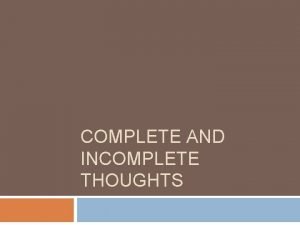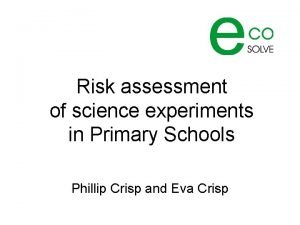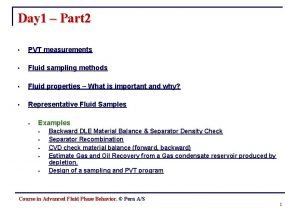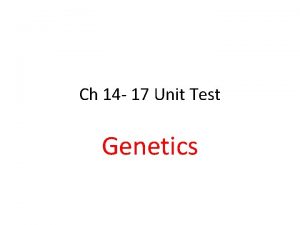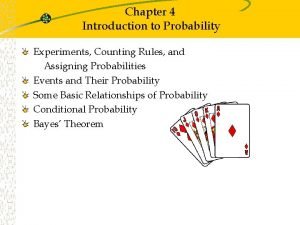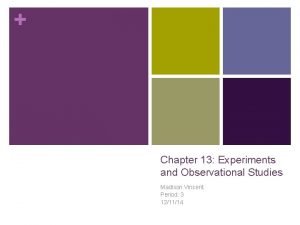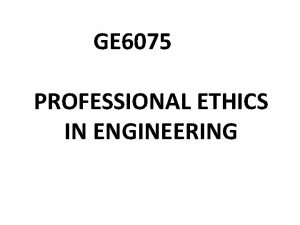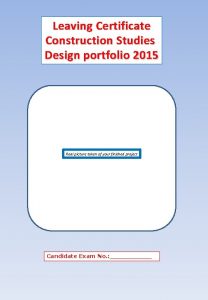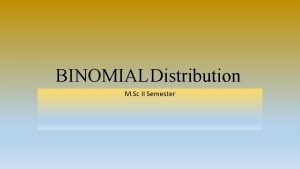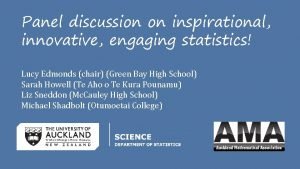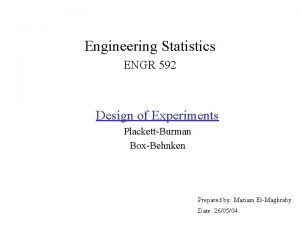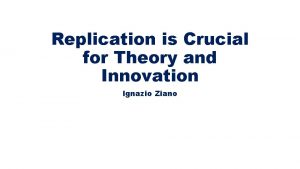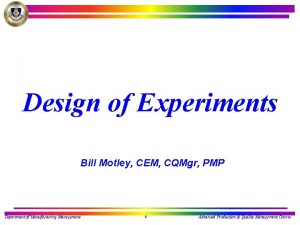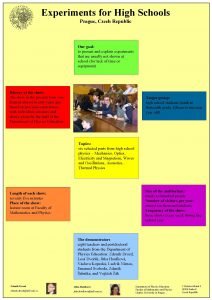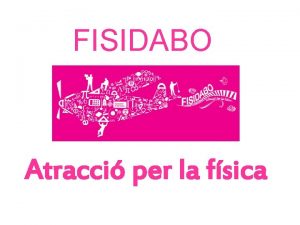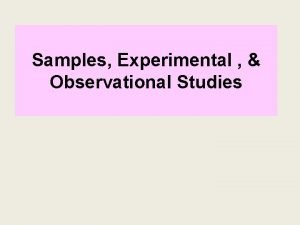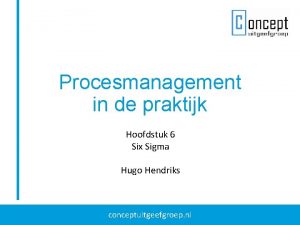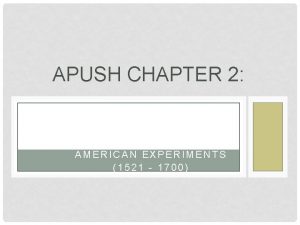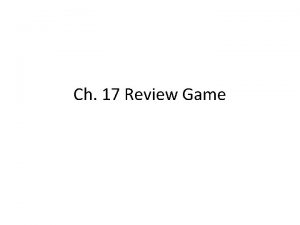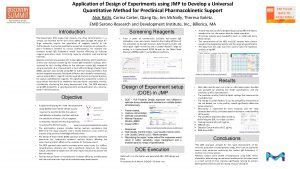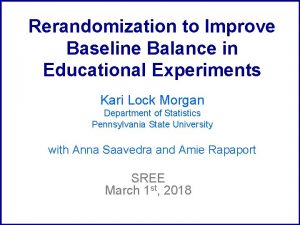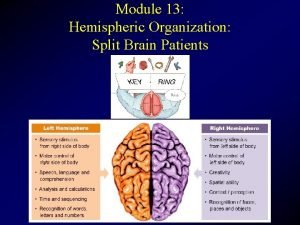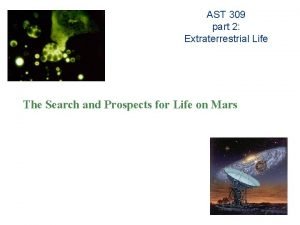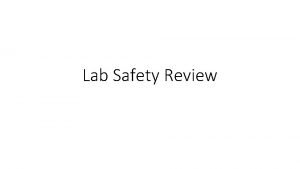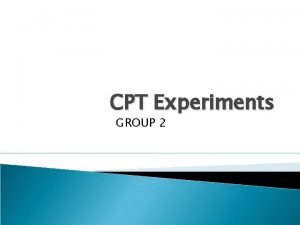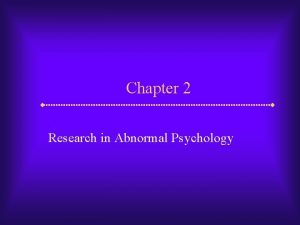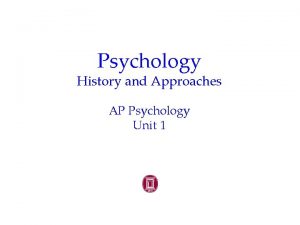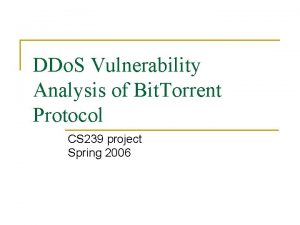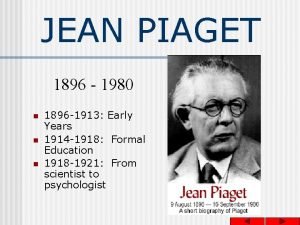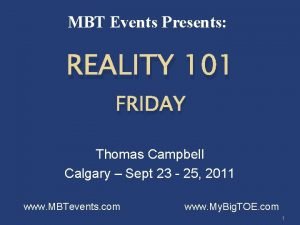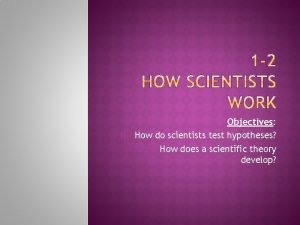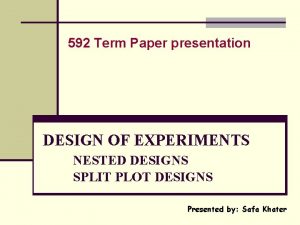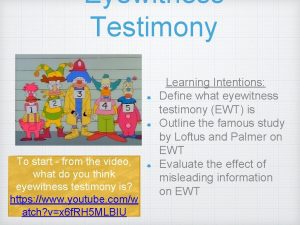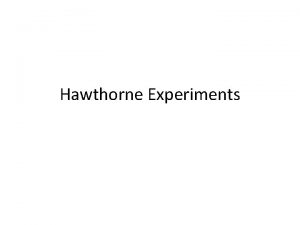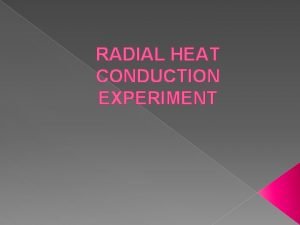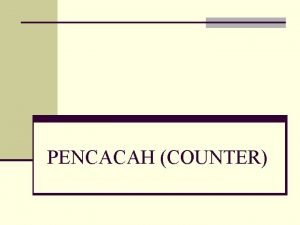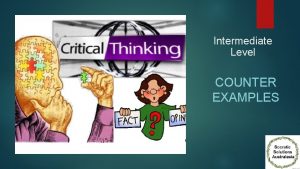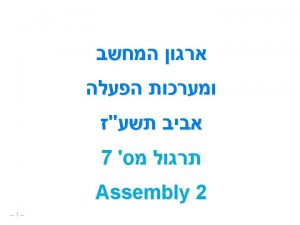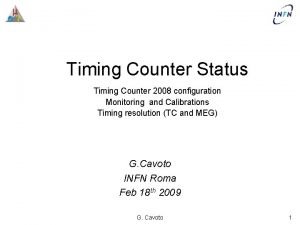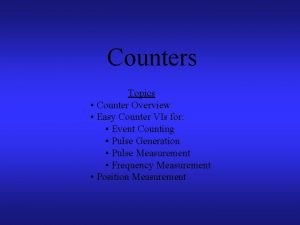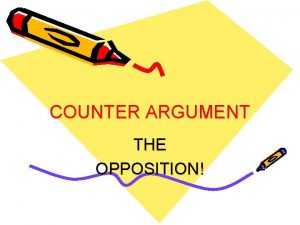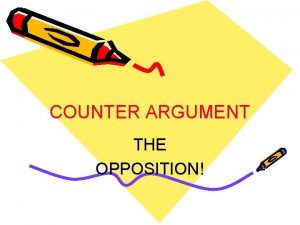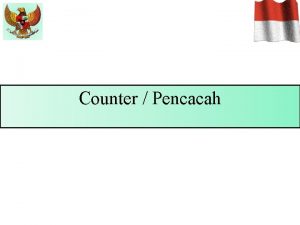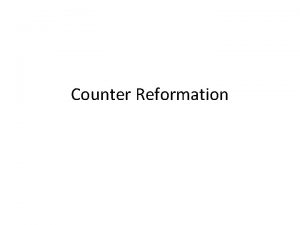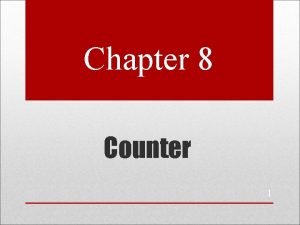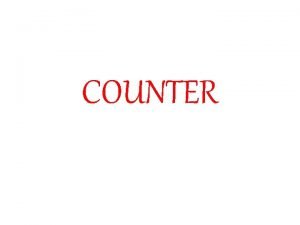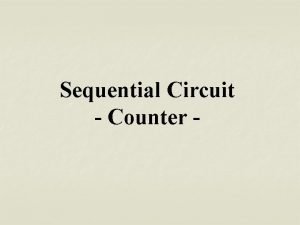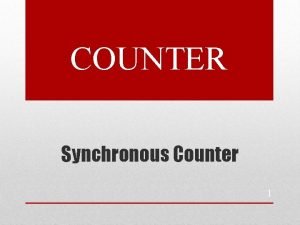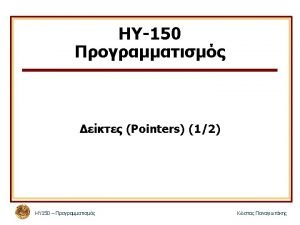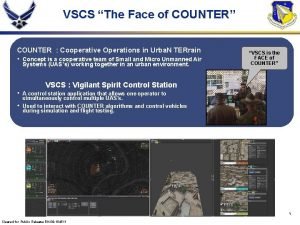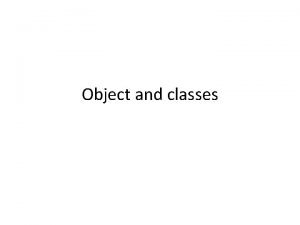Thought Experiments Lecture 10 Counter Thought Experiments A








































- Slides: 40

Thought Experiments Lecture 10 Counter Thought Experiments

A Muse of Fire Active imagination vs “willing suspension of disbelief” In some TEs we are not merely carried on but must participate.

Examples of Negative TEs 1. (a) Show theory self-contradictory (Einstein chasing a light beam, Galileo against Aristotle on falling bodies) (b) Contrary to other established (common sense) beliefs (Schrödinger’s cat) In terms of logic: they show the premisses to be false. 2. Show situations that undermine inferences (strange topologies or Poincaré’s disk people against Lucretius) In terms of logic: they show the argument to be invalid.

3. Counter TEs Galileo against Aristotelians (principle of relativity) Mach against Newton (absolute space) Dennett against Jackson (physicalism) • These should not be understood in terms of logic (ie, not about validity or soundness). • Rather, counter TEs deny the phenomena of some prior TEs.

Boundaries of an experiment • Theory vs experiment – Fuzzy distinction, theory-laden perception, etc. • Experiment in the broad sense vs narrow sense – Narrow: the set up and observation (which may be highly theory-laden) – Broad: the setup, observation, additional theorizing, calculating, drawing final conclusion (ie, from first conception to the final published result). • No sharp boundary between theory and experiment, nor between narrow and broad experiment (whether real or TE).

Broad TE Narrow TE TE set up Observed phenomenon TE result We can see the possible objections: 1. Challenge premisses (question setup, background) 2. Challenge inference: narrow → broad (question validity) 3. Challenge phenomenon (question what is “seen”)

Lucretius Two TEs that undermine Lucretius: – Topology of a sphere – Poincaré’s disk • They both accept the set up and the phenomenon of the TE (ie, we never come to an edge). • They deny the conclusion (infinite space) follows from this. • They (in effect) attack the validity of Lucretius’s TE • Thus, they accept Lucretius’s TE in the narrow sense, but deny it in the broad sense.

Searle & Thompson • Searle’s Chinese room – Person in room handles Chinese writing OK, but doesn’t know Chinese. Thus, AI is false. • Thompson’s violinist – Hooked to a violinist (innocent, has right to life), for 9 months. Morally OK to unhook. Abortion is analogous, thus permissible. – Criticisms of these TEs have been mainly directed at their conclusions, not at the TEs in narrow sense. – The phenomena of these TEs have not been challenged. – Attacks aimed at validity.

Complete rejection • Sometimes a TE is completely rejected. – Einstein dismisses Newton because of the “epistemological defect” – Dennett dismisses Jackson with remarks about “intuition pumps” and “folk knowledge” • Ignore this strategy here.

Denying TE phenomenon by means of a Counter TE • Galileo denies Aristotelian Tower TE concerning moving earth • Mach denies Newton’s TE concerning absolute space • Dennett denies Jackson’s TE concerning physicalism

Galileo on the moving earth Common Aristotelian TE: Suppose the earth moves. Then a dropped object would fall behind us as we move along, it would not fall straight down. But, as a matter of fact, it does fall straight down. Thus, the earth does not move. Galileo’s counter TE: Shut yourself up with some friend in the main cabin below decks on some large ship, and have with you there some flies, butterflies and other small flying animals. Have a large bowl of water with some fish in it; hang up a bottle that empties drop by drop into a wide vessel beneath it. With the ship standing still, observe carefully how the little animals fly with equal speed to all sides of the cabin. The fish swim indifferently in all directions; the drop falls into the vessel beneath; and, in throwing something to your friend, you need throw no more strongly in one direction than another, the distances being equal; jumping with your feet together, you pass equal spaces in every direction. When you have observed all these things carefully (though there is no doubt that when the ship is standing still everything must happen in this way), have the ship proceed with any speed you like, so long as the motion is uniform and not fluctuating this way and that. You will discover not the least change in all the effects named, nor could you tell from any of them whether the ship was moving or standing still. (Dialogo 186 f)

Galileo’s conclusion • Whether the earth is moving or not, things would act the same. (This is the principle of relativity. ) • Thus, the Aristotelian TE fails. (It remains possible that the earth moves. ) • This is a counter TE. • It denies the phenomenon in the original TE.

Newton’s Bucket Absolutism (substantivalism): space is a substance that exists without depending on anything else. It is the source of inertia. Relationalism: space is a system of relations. If there were no bodies, there would be no space.

Newton’s absolutism “Absolute space, in its own nature, without relation to anything external, remains always similar and immovable. Relative space is some movable dimension or measure of the absolute spaces; which our senses determine by its position to bodies. . . ” (Principia, 6)

Leibniz Shift U U

Leibniz: Sufficient Reason • God could have no reason for putting the U in one place in absolute space rather than any other. (Symmetry) • But God can only act for a reason. • Since we do have a U it cannot be located in absolute space. • Similar argument against absolute time. • Leibniz’s religious arguments can be reformulated as symmetry arguments.

Newton’s bucket “. . . the surface of the water will at first be flat, as before the bucket began to move; but after that, the bucket by gradually communicating its motion to the water, will make it begin to revolve, and recede little by little from the centre, and ascend up the sides of the bucket, forming itself into a concave figure (as I have experienced), and the swifter the motion becomes, the higher will the water rise, till at last, performing its revolutions in the same time with the vessel, it becomes relatively at rest in it. ”

I: water flat and at rest wrt bucket II: water rotating wrt bucket III: water at rest wrt bucket, but surface is concave What’s the difference between I and III ? Newton: water is rotating wrt space itself

Newton’s globes in empty space “It is indeed a matter of great difficulty to discover. . . the true motions of particular bodies from the apparent; because the parts of that immovable space. . . by no means come under the observation of our senses. Yet the thing is not altogether desperate. . . For instance, if two globes, kept at a distance one from the other by means of a cord that connects them, were revolved around their common centre of gravity, we might, from the tension of the cord, discover the endeavour of the globes to recede from the axis of their motion. . . And thus we might find both the quantity and the determination of this circular motion, even in an immense vacuum, where there was nothing external or sensible with which the globes could be compared. But now, if in that space some remote bodies were placed that kept always position one to another, as the fixed stars do in our regions, we could not indeed determine from the relative translation of the globes among those bodies, whether the motion did belong to the globes or to the bodies. But if we observed the cord, and found that its tension was that very tension which the motions of the globes required, we might conclude the motion to be in the globes, and the bodies to be at rest. . . ” (Principia, 12)

Spheres in empty space Tension in cord

• Leibniz had no reply to this. • Position and velocity are not observable, but acceleration is. • Bucket and rotating globes seemed to establish absolutism. • First serious challenge to Newton on rotation was from Berkeley and Mach.

Mach: empiricism & inertia “If we think of the Earth at rest and the other celestial bodies revolving around it, there is no flattening of the Earth. . . at least according to our usual conception of the law of inertia. Now one can solve the difficulty in two ways; either all motion is absolute, or our law of inertia is wrongly expressed. . . I [prefer] the second. The law of inertia must be so conceived that exactly the same thing results from the second supposition as from the first. ” (History and Root of the Principle of the Conservation of Energy, 1872 )

Mach’s Counter TE: “Newton’s experiment with the rotating water bucket teaches us only that the rotation of water relative to the bucket walls does not stir any noticeable centrifugal forces; these are prompted, however, by its rotation relative to the mass of the Earth and the other celestial bodies. Nobody can say how the experiment would turn out, both quantitatively and qualitatively, if the bucket walls became increasingly thicker and more massive and eventually several miles thick. ” (Science of Mechanics 1883)

Mach’s strategy • Mach proposes new theory: source of inertia is NOT space, but rather is (mainly distant) mass. • Rejects Newton’s TE in the narrow sense (ie, denies phenomenon). – Claim: If we could rotate a large mass around bucket, water would climb the walls – Claim: In an empty universe the two balls would not act the way Newton says • These are Counter TEs. Mach is challenging the phenomena that Newton assumes.

Jackson on Physicalism • Qualia are the subjective aspects of experience, feelings of hunger, pleasure, anger, and sensations of colour, smell, and so on. They are accessible to introspection. (One quale, many qualia. ) • The status of qualia is central to the mind-body problem. Physicalists claim that there is nothing over and above physical facts. • Are qualia different? Can they be reduced to the physical, or perhaps eliminated? • If not, then physicalism is wrong.

Jackson’s TE “Mary is a brilliant scientist who is, for whatever reason, forced to investigate the world from a black and white room via a black and white television monitor. She specialises in the neurophysiology of vision and acquires, let us suppose, all the physical information there is to obtain about what goes on when we see ripe tomatoes, or the sky, and use terms like ‘red’, ‘blue’, and so on. She discovers, for example, just which wavelength combinations from the sky stimulate the retina, and exactly how this produces via the central nervous system the contraction of the vocal chords and expulsion of air from the lungs that results in the uttering of the

sentence ‘The sky is blue’. (It can hardly be denied that it is in principle possible to obtain all this physical information from black and white television, otherwise the Open University would of necessity need to use colour television. ) What will happen when Mary is released from her black and white room or is given a colour television monitor? Will she learn anything or not? It seems just obvious that she will learn something about the world and our visual experience of it. But then it is inescapable that her previous knowledge was incomplete. But she had all the physical information. Ergo there is more to have than that, and Physicalism is false.

Clearly the same style of Knowledge argument could be deployed for taste, hearing, the bodily sensations and generally speaking for the various mental states which are said to have (as it is variously put) raw feels, phenomenal features or qualia. The conclusion in each case is that the qualia are left out of the physicalist story. And the polemical strength of the Knowledge argument is that it is so hard to deny the central claim that one can have all the physical information without having all the information there is to have. ” (Jackson, “Epiphenomenal Qualia”, Philosophical Quaterly, Vol. 32, No. 127. 1982, 127 -136)

The knowledge argument 1. Mary knows all the physical facts about colour perception. 2. She has learned these facts having only black and while experiences. 3. When she experiences colour for the first time, she learns something new. Therefore, some facts about colour are not physical facts.

The structure of Jackson’s TE: Set up: Mary in black & white room, learns all physical facts about perception. Phenomenon: When she first encounters colours, she learns something new. Result: Some facts about perception are not physical. Hence, physicalism is wrong. A counter TE would accept the set up, but challenge the phenomenon.

Dennett’s outright rejection “Like a good thought experiment, its point is immediately evident even to the uninitiated. In fact it is a bad thought experiment, an intuition pump that actually encourages us to misunderstand its premises. ” (Dennett, Consciousness Explained, 1991, 398). “TEs depend on folk concepts; they are inherently conservative. We should expect very counter intuitive results in real science, so violating our intuitions is to be expected. ” (Sweet Dreams, 2005, 128 f)

Reply to Dennett’s dismissal • So called “folk concepts” used in TEs can (and often do) lead to revolutionary results: – – – – Galileo on free fall → new mechanics Poincaré’s disk → non-Euclidean geometry Einstein’s elevator → principle of equivalence Thompson’s violinist → morality of abortion Arithmetic → infinitude of primes Peano axioms → Gödel incompleteness Turing computability → uncomputable functions • It’s a mistake to think starting with common sense must end in common sense. • Fortunately, Dennett, plays the TE game, anyway.

Dennett’s counter TE “And so, one day, Mary’s captors decided it was time for her to see colours. As a trick, they prepared a bright blue banana to present as her first colour experience ever. Mary took one look and said “Hey! You tried to trick me! Bananas are yellow, but this one is blue!” Her captors were dumbfounded. How did she do it? “Simple, ” she replied, “ you have to remember that I know everything — absolutely everything — that could ever be known about the physical causes and effects of colour vision. So of course before you brought the banana in, I had already written down, in exquisite detail, exactly what physical impressions a yellow object or a blue

object (or a green object, etc. ) would make on my nervous system. So I already knew exactly what thoughts I would have (because, after all, the mere disposition to think about this or that is not one of your famous qualia, is it? ). I was not in the slightest surprised by my experience of blue (what surprised me was that you would try such as second-rate trick on me). I realise that it is hard for you to imagine that I could know so much about my reactive dispositions that the way blue affected me came as no surprise. Of course it’s hard for you to imagine. It’s hard for anyone to imagine the consequences of someone knowing absolutely everything physical about anything!” (Dennett, Sweet Dreams, 1991, 399 -400)

Dennett = Mach = Galileo • The structure of Dennett’s TE is the same as Mach’s and Galileo’s. They are all Counter TEs. • The challenge is not: given the TE we should resist the anti-physicalist conclusion (ie, not against the broad TE). • Rather, the challenge is that the narrow TE is faulty: Mary would not learn anything new. • Dennett, Mach, and Galileo deny the phenomena of the initial TEs.

Dennett realizes this: “My variant was intended to bring out the fact that, absent any persuasive argument that this could not be the way Mary would respond, my telling of the tale had the same status as Jackson’s: two little fantasies pulling in opposite directions, neither with any demonstrated authority. ” (Dennett, Sweet Dreams, 105)

Alternative challenges The Newton and Jackson TEs might also be challenged in the broad sense (ie, by accepting the phenomena of the TE but offering a different explanation). • Contra Newton: Sklar’s “absolute acceleration” • Contra Jackson: Lewis’s “ability hypothesis” (knowing how, not knowing that) • Evaluation in these cases takes the form: Who offers the best explanation of an accepted phenomena?

When does a Counter TE work? • Only when the counter TE-er can plausibly deny the phenomenon of the original TE. • No one denies the phenomena in TEs by – Searle (Chinese room) – Lucretius (infinite space) – Thompson (violinist) • NB: Geach on God and moral dilemmas. • Challenges to these TEs accept the phenomena but deny the conclusions drawn from them.

Things that seem to matter • How reliable is the initial TE (in the narrow sense)? – How strong is the assumed background to the TE? – How similar is the phenomenon of the TE to things we know and trust? • How plausible is the phenomenon of the Counter TE? – How absolutely plausible? – How relatively plausible?

Comparisons • Galileo is completely triumphant. The Aristotelian TE is destroyed. • Newton weakened but not destroyed. Mach is an alternative, but it is not as plausible. • Jackson is nullified. Dennett’s alternative story is just as plausible. It’s a tie. • This evaluation is very rough and open to objection. • It’s merely my take on things after minimal consideration. • Main aim is to determine how Counter TEs work, not to evaluate particular instances.
 01:640:244 lecture notes - lecture 15: plat, idah, farad
01:640:244 lecture notes - lecture 15: plat, idah, farad Complete incomplete thought
Complete incomplete thought Science experiment risk assessment
Science experiment risk assessment Pvt sample
Pvt sample In his transformation experiments what did griffith observe
In his transformation experiments what did griffith observe Counting rule for multiple-step experiments
Counting rule for multiple-step experiments Chapter 13 experiments and observational studies
Chapter 13 experiments and observational studies Balanced outlook on law
Balanced outlook on law Construction portfolio leaving cert example
Construction portfolio leaving cert example Merits of standard deviation
Merits of standard deviation Pros and cons of animal testing
Pros and cons of animal testing Liz sneddon experiments
Liz sneddon experiments Plackett burman method
Plackett burman method Why is “replication key” psychology experiments?
Why is “replication key” psychology experiments? Design of experiments pmp example
Design of experiments pmp example Czech experiments
Czech experiments Computer architecture lab experiments
Computer architecture lab experiments Fisidabo
Fisidabo Survey vs observational study
Survey vs observational study Design of experiments voorbeeld
Design of experiments voorbeeld American experiments chapter 2
American experiments chapter 2 Miller and urey's experiments attempted to demonstrate
Miller and urey's experiments attempted to demonstrate Science experiments for highschool
Science experiments for highschool Core flooding experiment
Core flooding experiment Doe in jmp
Doe in jmp Rerandomization to improve covariate balance in experiments
Rerandomization to improve covariate balance in experiments Split brain experiments
Split brain experiments Viking experiments
Viking experiments Does hot glass look the same as cold glass
Does hot glass look the same as cold glass Experiments in goodness
Experiments in goodness Abnormal psychology experiments
Abnormal psychology experiments 1928 frederick griffith
1928 frederick griffith G stanley hall ap psychology
G stanley hall ap psychology Ddo vulnerability
Ddo vulnerability Coordination of secondary circular reactions
Coordination of secondary circular reactions Tom campbell experiments
Tom campbell experiments Why are controlled experiments sometimes impossible
Why are controlled experiments sometimes impossible Paper presentation design
Paper presentation design Eyewitness testimony video experiments
Eyewitness testimony video experiments Mass interviewing programme
Mass interviewing programme Linear and radial heat conduction
Linear and radial heat conduction

